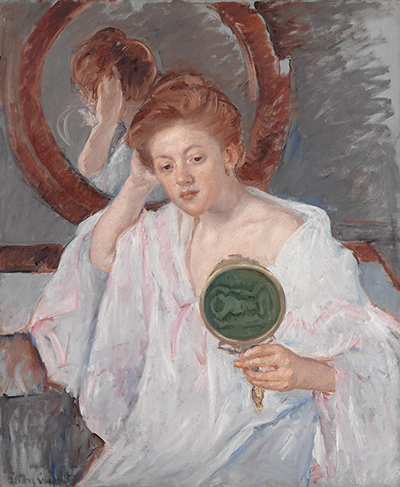Denise at her Dressing Table was produced by Mary Cassatt in circa 1908-1909 and it now resides within the The Metropolitan Museum of Art in New York, USA. It is one of half a dozen artworks by this artist which can be found within their permanent collection.
This charming piece was completed entirely in oils which was the most common medium found within Cassatt's career, though she also produced a large number of pastel drawings as well. Here we find a young woman in an indoor setting, most likely a bathroom or a corner of her bedroom. She is posed as if looking directly into her hand mirror though actually her eyes are focused slightly to the side. She wears a very casual nightdress which is predominantly white, but features pink lace around the trim. It hangs down loosely, revealing part of her open chest. Her hair is smart, red and up in a bun, as was common during this period. She leans to the side, with her head on a right hand. Her left hand holds up an ornate hand mirror, and behind her is a larger mirror which hangs on the wall. That item is round, with a wooden frame on a grey wall which Cassatt only loosely finishes. There is also some furniture on which she sits, which looks like a relaxed item for enjoying on one's own rather than in a social capacity.
The larger mirror allows Cassatt to experiment with offering us two different angles of the model's head. Denise, as we know her from the title of the piece, has her hand touching the side of her hair, though the artist does not include too much other information within the mirror's view. She regularly made use of models with auburn coloured hair, as well as blonde children and so this must have been her preference as darker haired figures are far more common within this part of France. Perhaps she appreciated the very fair complexions that normally came with such hair colour, with people at the time would consider a sign of feminity and purity. Today, of course, opinions are much more varied and the idea of beauty can be very different from one person to the next. This view of that era is also found in the British Pre-Raphaelites who typically chose pale skinned models for their portraits as well, and this look retains a classical style that remains popular with many art followers today.
There have been suggestions that the decision to feature the same portrait but from different angles, via the mirror, was Cassatt's comment on the vanity of women, although this cannot be confirmed. The artist would sadly stop painting just a few years after this portrait was completed due to failing eyesight which is an afflication that has ended many an artistic career. You could argue that even within this painting, there are signs of a deterioration in the quality of some aspects of her work, though it is still a work worthy of note and it is worth seeing in person at the The Metropolitan Museum of Art in the US. They have five other items from her career too, with a mixture of pastels and oil paintings spanning several decades. Those interested in Cassatt's career should also check out other famous works such as The Child's Bath, Little Girl in a Blue Armchair and The Boating Party.




